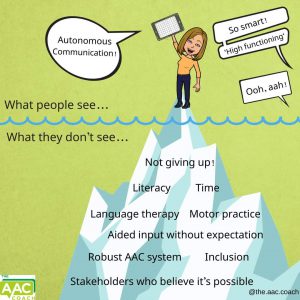 This picture from AAC Coach says so much about the nature of success with communication when using AAC. A few years ago I chatted with a college student who was able to fluidly answer my questions while typing on her iPad. It seemed impossible the story she was sharing was true – that until middle school she had been treated as though she had a significant intellectual disability, denied access to inclusive classrooms, and overheard teachers making comments that her parents “should just institutionalize her”. Yet here was this put together, bright college student who only stuck out because she typed her replies to me instead of speaking them aloud. It would be easy to assume from that conversation that all she needed was typing lessons and an iPad – but it is so much more than that.
This picture from AAC Coach says so much about the nature of success with communication when using AAC. A few years ago I chatted with a college student who was able to fluidly answer my questions while typing on her iPad. It seemed impossible the story she was sharing was true – that until middle school she had been treated as though she had a significant intellectual disability, denied access to inclusive classrooms, and overheard teachers making comments that her parents “should just institutionalize her”. Yet here was this put together, bright college student who only stuck out because she typed her replies to me instead of speaking them aloud. It would be easy to assume from that conversation that all she needed was typing lessons and an iPad – but it is so much more than that.
Using Wordless Shorts to Inspire Language
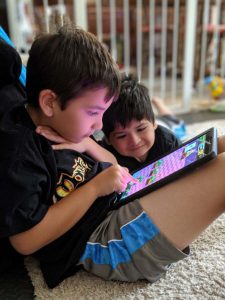 A few weeks ago I was able to watch a webinar from Lauren Enders in regards to fun activities to jumpstart AAC learning. Last week I shared how much the need for making our lessons fun and connecting with our students resonated with me, particularly as we begin to meet with our students in person and may feel pressured to make up for lost time.
A few weeks ago I was able to watch a webinar from Lauren Enders in regards to fun activities to jumpstart AAC learning. Last week I shared how much the need for making our lessons fun and connecting with our students resonated with me, particularly as we begin to meet with our students in person and may feel pressured to make up for lost time.
I loved many of the ideas Ender shared, and one that I cannot wait to use with Joey is to use wordless animated short videos. Although I have always loved wordless books it had never occurred to me to use wordless videos to encourage language use.
Accessing Online Resources with AAC
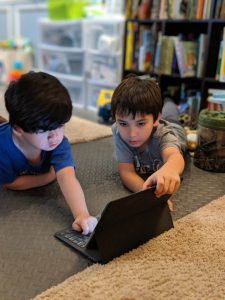 I rely heavily on the Pioneer Valley Book Builder subscription to create books for the children I work with. You can put a child’s name into the program and print out a book at the child’s guided reading level with their name within the text. This is a great resource, especially during this time of quarantine. As I was exploring the site the other day I came upon their Digital Reader, which is currently free. It allows you to access books digitally at your child’s specific reading level (they also have a free assessment if you are not sure where to start). There are even videos for some of the books that will guide the students through introducing the book, word work connected with the book, as well as writing connections with the book.
I rely heavily on the Pioneer Valley Book Builder subscription to create books for the children I work with. You can put a child’s name into the program and print out a book at the child’s guided reading level with their name within the text. This is a great resource, especially during this time of quarantine. As I was exploring the site the other day I came upon their Digital Reader, which is currently free. It allows you to access books digitally at your child’s specific reading level (they also have a free assessment if you are not sure where to start). There are even videos for some of the books that will guide the students through introducing the book, word work connected with the book, as well as writing connections with the book.
As I watched my own kindergarten daughter participate in this virtual guided reading lesson from guided reading guru Jan Richardson, I couldn’t help but think of Joey – can these resources work for him as well?
ACC Everywhere
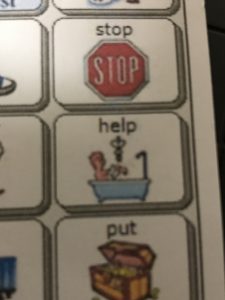 So often, people who use AAC to communicate find themselves caught in the ability to only communicate with those who understand how AAC devices work in situations where AAC devices are available. It can be a small world in which to communicate. And yet, those of us who are able-bodied are only currently able-bodied. It is not something any of us want to think about, but any of us are capable of one day relying on AAC supports in order to reach the world around us.
So often, people who use AAC to communicate find themselves caught in the ability to only communicate with those who understand how AAC devices work in situations where AAC devices are available. It can be a small world in which to communicate. And yet, those of us who are able-bodied are only currently able-bodied. It is not something any of us want to think about, but any of us are capable of one day relying on AAC supports in order to reach the world around us.
Somewhere in my quarantined on-line searches I stumbled upon this resource page from the Patient-Provider Communication Forum. The resources were developed by speech-language pathologists, nursing leaders, engineers, and with help from the U.S. Society of Augmentative and Alternative Communications. It provides pages of low-tech pictures that can be provided to people with COVID-19 who are unable to communicate.
Sharing Joey’s Story
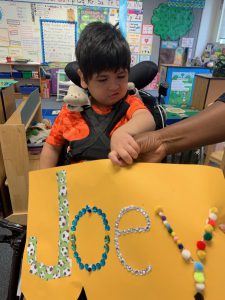 I found myself getting nervous before my opportunity to present the research on Joey’s progress at the Council for Exceptional Children’s DADD conference in January. Joey’s journey is unique, but as I scrolled through my prepared slides I wondered if I was on the right track. So much of my work with Joey has involved throwing off what I was taught in terms of behavioral approaches and meeting Joey where he asks to be met. Not what I plan for Joey to do, or what I’ve done with students in the past, but where Joey shows me he is ready to work. Although this is the right approach for Joey, and I truly believe in the approaches we take for him, I realized I was nervous about the response I would get. Sometimes it just feels too different than the otherwise straightforward approaches to teaching communication. The audience of this conference included many doctoral degrees and experts in the field. What if I was doing everything wrong, and everyone heard me say it aloud? [Read more…]
I found myself getting nervous before my opportunity to present the research on Joey’s progress at the Council for Exceptional Children’s DADD conference in January. Joey’s journey is unique, but as I scrolled through my prepared slides I wondered if I was on the right track. So much of my work with Joey has involved throwing off what I was taught in terms of behavioral approaches and meeting Joey where he asks to be met. Not what I plan for Joey to do, or what I’ve done with students in the past, but where Joey shows me he is ready to work. Although this is the right approach for Joey, and I truly believe in the approaches we take for him, I realized I was nervous about the response I would get. Sometimes it just feels too different than the otherwise straightforward approaches to teaching communication. The audience of this conference included many doctoral degrees and experts in the field. What if I was doing everything wrong, and everyone heard me say it aloud? [Read more…]
- « Previous Page
- 1
- 2
- 3
- 4
- …
- 18
- Next Page »


